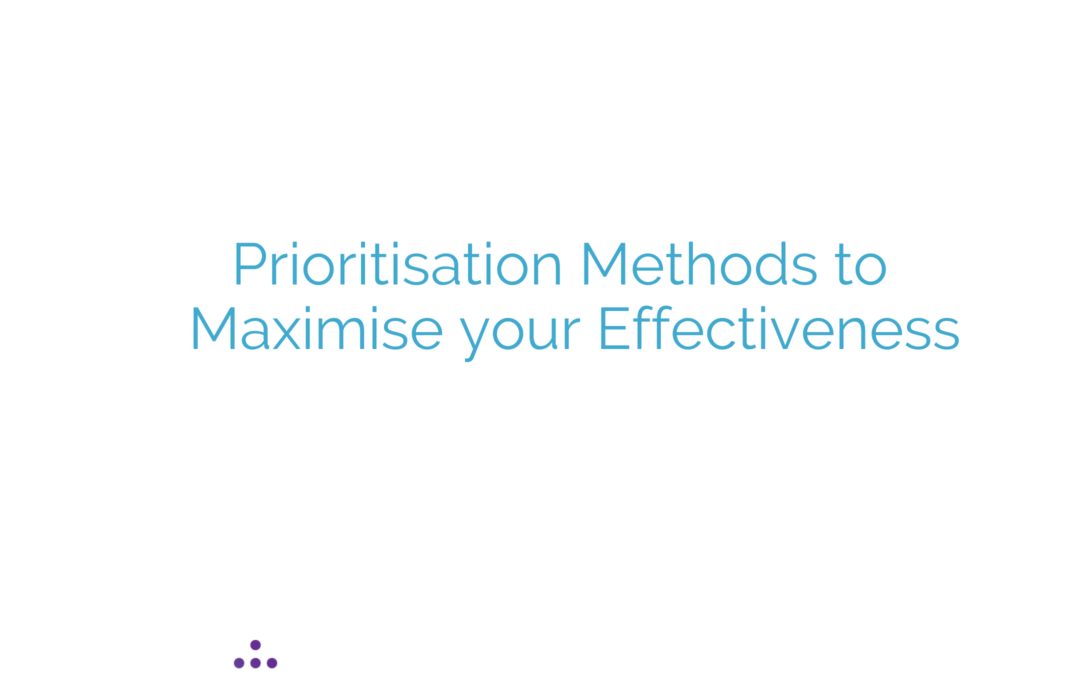
The ability to prioritise work is one of the key skills that employees must master to maximise their own workplace performance and effectiveness. Prioritisation can be defined as the act of deciding the relative importance of a thing that moves us towards a single goal. Prioritisation might sound simple but it is not as easy to implement. It takes some effort and planning to ensure the right tasks are prioritised.
In this article, I will share some simple steps that will help you to increase your prioritisation skills, eliminate procrastination and restore focus to ensure you maximise your professional performance and effectiveness.
Prioritisation Methods to Maximise your Effectiveness:
- Create a comprehensive list. It is impossible to prioritise your tasks if they are just in your head. Start by writing down all the tasks that need to be completed. Think of this as a brain dump. Once this step is completed, you will then separate the tasks that are urgent from the tasks that are important. One method to help with this is the Eisenhower Matrix.
- The Eisenhower Matrix. This matrix was created by Steven Covey who is the bestselling author of The 7 Habits of Highly Effective People. Steven Covey recommends creating a list of urgent, important, and trivial tasks using four quadrants. When looking at how to prioritise tasks, ask which one of the quadrants they best fit in:
- Urgent and Important: Do these tasks as soon as possible.
- Important, but not urgent: Decide when you’ll do these and schedule it.
- Urgent, but not important: Delegate these tasks to someone else
- Neither urgent nor important: Drop these from your schedule as soon as possible.
This matrix will help you distinguish between necessary tasks and time wasters that hold back your progress.
- The Ivy Lee Method. If you have created a large list of urgent and important tasks to get done, the Ivy Lee Method is a great method for prioritising daily tasks. Follow these simple set of rules:
- At the end of each workday, write down the six most important things you need to accomplish tomorrow. Do not write more than six tasks.
- Prioritise those six items in order of their true importance.
- When you arrive tomorrow, concentrate on the first tasks. Work until the first task is finished before moving on to the next one.
- Approach the rest of your list in the same way. At the end of the day, move any unfinished items to a new list of six tasks for the following day.
- Repeat this process every working day.
- The ABCDE Method. If you want to separate tasks with similar priorities, Brian Tracy’s ABCDE method is the one to use. Here is how it works:
- Go through your list and give every task a letter from A to E (A being the highest priority).
- For every task that has an A, give it a number which dictates the order you will do it in.
- Repeat until all tasks have letters and numbers.
- Eat That Frog Method. This technique is named after a Mark Twain quote: “Eat a live frog first thing in the morning and nothing worse will happen to you the rest of the day”. Start your day by doing the most onerous tasks first and getting them out of the way. Your frogs each day are the tasks that will have the greatest impact on achieving your goals, which are usually the tasks that you’re most likely to procrastinate on. By doing this, you are setting the tone to have a productive day. How this method works:
- Get clear on a goal. What do you want to achieve the most?
- Write it down.
- Set a deadline.
- Compile a list of things you need to do to achieve your goal.
- Organise this list in order of priority. The most important items are probably the most difficult. These are your “frogs”.
- Take action. If you have more than one frog on your plate, eat the nastiest one first.
- Repeat this cycle every day so that you are always doing something that will push you toward your goal.
I hope you enjoyed reading this article and that you have learned some methods that will help you to prioritise your work effectively. Please share this article with anyone who might benefit from it.
© Maria O'Dwyer Coaching. Unauthorised use and/or duplication of this material without express and written permission from this site’s author and/or owner is strictly prohibited. Excerpts and links may be used, provided that full and clear credit is given to Maria O'Dwyer Coaching with appropriate and specific direction to the original content.

